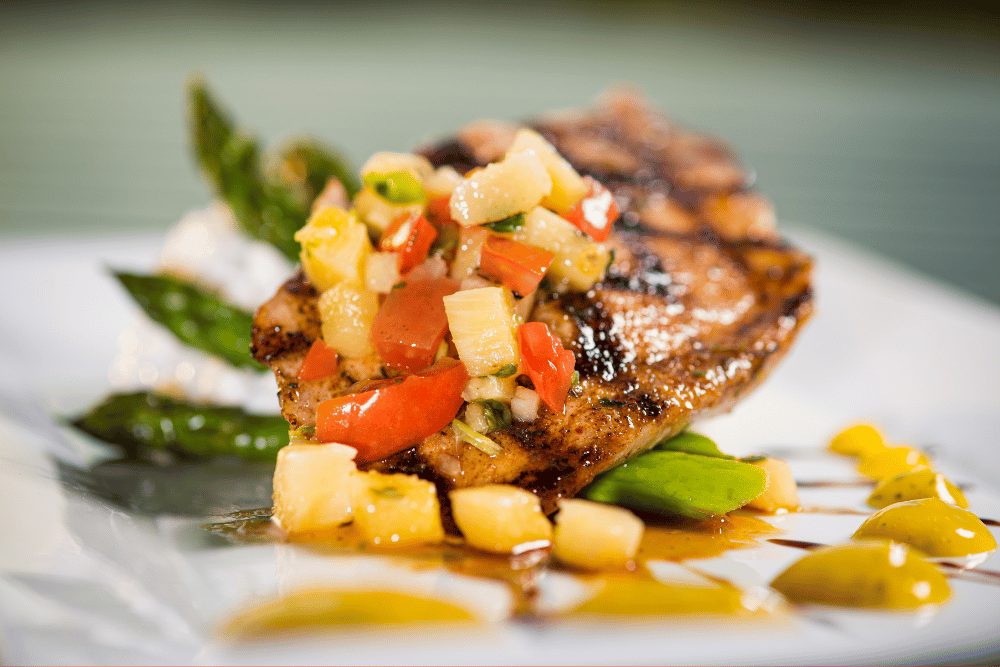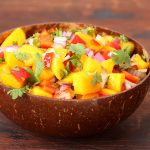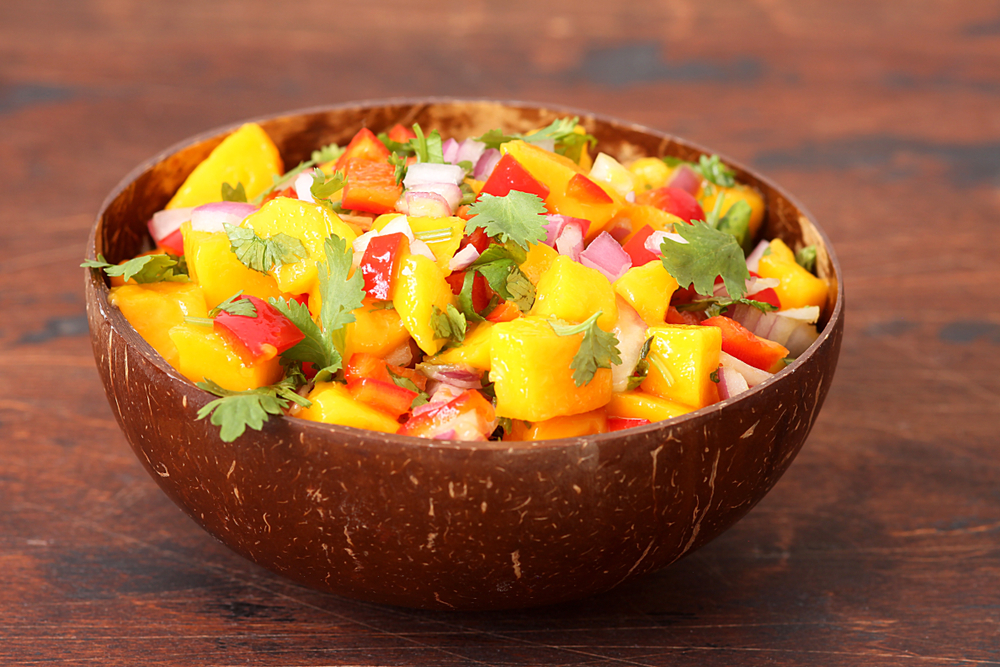Mango habanero salsa is one of the best examples of how sweet and fruity flavors combine beautifully with chili peppers' heat. The combination of fresh mangos with the intense heat of habaneros makes this spicy salsa the perfect topping to just about any Mexican or Latin dish or eaten as a simple appetizer with crisp tortilla chips.
What Are The Ingredients In Mango Habanero Salsa?
Mango habanero salsa comprises a handful of fresh ingredients, making it fairly easy to prepare. Each ingredient plays a vital role in bringing this flavorful salsa to life and making it one of my absolute favorites for Mexican night!
Mangos
Ripe mangos are incredibly aromatic, juicy, and sweet. Their flavors range from citrusy, floral, and tropical, making them a versatile fruit and one of the key flavor components of this salsa.
Habanero Peppers
Habaneros are very spicy, so a little will go a long way! Remove the seeds, as the flesh alone will provide enough heat for the salsa. The smoky and fruity flavors in habaneros perfectly complement the juicy mangos.

Tomatoes
Use your favorite tomatoes for this salsa. I love using a beefsteak tomato, but even small cherry tomatoes will work. Romas and standard tomatoes on the vine also work well. To reduce the moisture content in your salsa, de-seed larger tomatoes first.
Cilantro
You want to ensure you’re using the freshest cilantro you can find. The aromatics of cilantro are essential for this salsa, so make sure to smell it before you buy it. Dried cilantro does not work well in salsa.
Limes
Citrus is a must when making a good salsa, and lime juice adds a wonderful tropical flavor and the necessary acidity.
Onion
I prefer to use small white onions when preparing salsa, as they tend to have the perfect flavor for this dish. However, both yellow and red onions will work great as well.
Garlic
Fresh garlic will provide herbal and pungent allium notes to balance the other flavors.
Salt and Pepper
As always, salt and pepper are to taste. You can add other spices, such as adobo seasoning, but this salsa is well-balanced with just the fresh ingredients listed above.
How Spicy Is Mango Habanero Salsa?
Habanero peppers are quite spicy, ranging between 100,000-250,000 SHUs on the Scoville scale. Using just one small habanero in your batch of salsa will give it immense heat.
I’d recommend adding it to taste until you are at the heat level you’re looking for. Once you’ve added the habanero, you can’t remove the heat as the pepper’s oils have already been incorporated into the salsa.
If you find that habaneros are simply too spicy for your palate, there are other hot peppers that you can substitute into this salsa that will work just as well with less heat.
- Aji dulce peppers are a great option, as they will retain a similar sweet and fruity flavor profile as the habanero, but with almost no heat, as they are only about 1,000 SHUs.
- If you want to remove all heat from this salsa, you can’t go wrong with using a simple red bell pepper or a Carmen pepper for even more sweetness.
- You can’t go wrong with your classic green or red jalapeno pepper if you want to keep some heat. Jalapenos have between 2,500-8,000 SHUs, which is still significant but won’t overwhelm you as habaneros do.
- Serranos will also work nicely, with even more heat at 8,000-22,000 SHUs.
Is Mango Habanero Salsa Fresh Or Cooked?
You can prepare this salsa either fresh or roasted. Both preparations have pros and cons, so let’s look at which will work best for your meal.
Combining all ingredients in their raw form in a chunkier salsa will leave you with all the bright and bold flavors. The bright acidity from the limes will bring out the mango’s sweetness and the habaneros’ intense heat. A fresh mango habanero salsa will go perfectly with fish tacos or on top of grilled or blackened chicken, as the freshness of the ingredients will pair well with a milder protein source.
Roasting your peppers and sauteing your mangos will allow for a good amount of char and caramelization. Cooking down the fruits will mellow out the intensity of all flavors, leaving you with a salsa that is more uniform in texture and flavor. I’d recommend using a roasted mango habanero salsa on a hearty and savory dish such as carne asada tacos or juicy beef machaca stuffed in a burrito with beans and rice.

What’s The Difference Between Mango Habanero Salsa And Hot Sauce?
You may have seen mango habanero hot sauce bottles in your local grocery store or at your favorite Mexican restaurant. While the flavor profile will be similar to mango habanero salsa, the hot sauce is slightly different.
Hot sauce tends to focus on increasing the spice level of your meal, so many mango habanero hot sauces will be more potent in the heat than traditional salsa. You’ll still get a lot of the sweetness from the mangos, but the habanero will tend to be upfront and center.
Texture is another key element that differs between hot sauce and salsa. For the most part, mango habanero hot sauces are cooked down and blended in a food processor to a completely smooth consistency. A fresh mango habanero salsa will be chunky and retain a lot of the textures of the raw ingredients, similar to a pico de gallo. Even if you decide to broil your peppers and cook down your mangos, the salsa will be soft but still have some of the fibers and mouthfeel of the original ingredients.
Finally, many hot sauces are heavy on the vinegar, and some are even fermented. In this case, the sweet heat from the mango and habanero will be backed by a tart and tangy finish.
Where To Buy Mango Habanero Salsa
Mango habanero salsa is readily available at most grocery stores in the Mexican/Latin American food aisle. Big-name brands such as Mrs. Renfro’s and Newman’s Own have popular store-bought mango and habanero salsas that even stand up to homemade salsa.
How To Make Homemade Mango Habanero Salsa
The following recipe is for a basic, fresh mango habanero salsa with very minimal prep time. This is the best introduction to this particular salsa, and the flavors of each ingredient will stand out beautifully. Once you’ve tried it fresh, feel free to experiment with roasting your peppers and sauteing your mangos to change the consistency and flavor profile of the salsa.
Print
Mango Habanero Salsa
Ingredients
2 ripe mangos, finely diced
1 cup tomatoes, finely diced
1 habanero pepper, deseeded and finely chopped
1 lime, juiced
1/2 cup fresh cilantro, finely chopped
1/2 small white onion, finely diced
3 cloves garlic, smashed and finely chopped
kosher salt and pepper, to taste
Instructions
- Prepare your fruits and veggies by washing them and removing any skins and stems.
- Cut mango in half, remove the pit, and then finely dice into cubes of about ¼ inch. Place the diced mango into a large mixing bowl.
- Dice your tomatoes, onion, and garlic and place into the mixing bowl.
- Cut lime in half, juice it, and add fresh lime juice to a large mixing bowl. Mix gently.
- Finely chop your cilantro, add it to the bowl and mix gently.
- Finely chop your deseeded habanero into tiny pieces. Slowly add small amounts of the pepper to your salsa and taste test for heat level. (Wear gloves when handling habaneros to prevent any burning sensations.)
- Add salt and pepper to taste. I recommend using about one teaspoon of salt to start. Mix salsa gently.
- Enjoy! This salsa will last for at least a week if you keep it in an airtight container.

